In modern city apartments, especially in multi-storey residential buildings, often only electrical wiring is provided. There is no gas supply here. For this reason, in kitchens you have to arrange stoves that operate on electricity. And many newcomers are puzzled, what is the principle of operation of this electrical equipment? And what is the structure of the electric stove?
Content
We deal with the basic equipment
Any modification of an electric stove made in our country or abroad has a similar device. But there are also their own specifics and subtleties.
For example, modern Hansa slabs made in Germany are characterized by special equipment. They have corresponding price tags. And not every ordinary user can afford them. Therefore, it is wiser to consider the standard version of the electric stove.
Traditionally, such devices are a certain technical combination. Her main task is cooking. It consolidated:
- Hob. Usually it is equipped with hobs.
- Oven. It is also called an oven.
- Department for the maintenance of dishes and useful accessories. It is arranged from below.
The principle of operation here is normative for many devices operating on electricity. That is, the current follows through the heater. This element is heated to a certain temperature, which is usually set by the user.
It’s convenient to operate the device, as there are regulators on the front console. They are mechanical or electronic. Here the class of the plate matters. There are a couple of indicators on this console:
- The first notifies about the start of the device, its inclusion in the power grid.
- The second informs about the launch of the oven.
- On some modifications there is only one indicator - the first.
Thanks to the controls, you can set the cooking mode of your dishes located in the oven or on the burner, and any.
The following is a diagram of the structure of a standard electric stove.
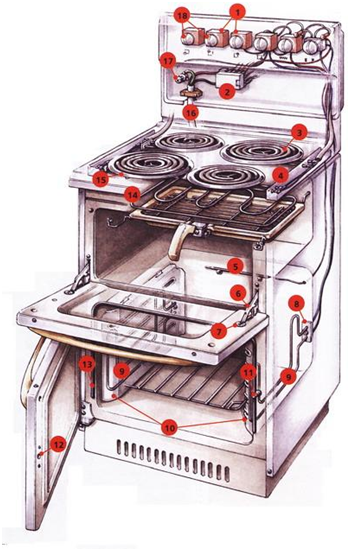
The following designations are reflected here:
- Power control device (regulator).
- Terminal capacity (box).
- Burner.
- Plank, creating a support.
- Temperature sensor in the oven.
- The loop.
- Stopper.
- Lock of the oven TENA.
- The oven itself is a heating element.
- Inner sheathing plane.
- Door latch holder.
- The nest of this latch.
- Gasket for insulation.
- Grill heater.
- Hob ring.
- Power cable.
- Ground terminal
- Handles for regulation.
Plate surface
The surfaces of such plates have different types. Today, taking into account technological progress, they are divided into the following categories:
- Enamelled surfaces. The burners are made of cast iron. The advantages of this device are as follows:
- affordable price;
- ease of maintenance and repair work.
Also, this coating has good resistance to mechanical stress. This is extremely important. After all, in the kitchen, the fall of small utensils and heavy dishes is not excluded.
There are also its weaknesses:- The food is cooked for quite some time.
- The percentage of thermal energy is wasted. This is especially evident when the burners turn off. And they cool extremely long. So only the air in the room is heated.
- Cleaning the surface is a rather time-consuming task. It takes a lot of time. The use of special chemicals is required.
- Glass-ceramic surfaces. They are on many modern models. As a result, the boards have a very aesthetic and stylish look. Other strengths are:
- The entire cooking area is covered by a sheet with a ceramic surface. It is characterized by the highest durability.
- Only the cooking zone is heated. This is a guarantee of safe use.
- The surface is perfectly smooth. Thanks to what the ware does not accidentally tip over.
- The maximum diameter of the burners is 60 cm.
- Hot plates quickly heat up and cool down. The heating component is working intensively. It takes a minute for it to cool completely.
- The surface is easy to care for. It is laundered simply and using mild cleaning products.
- The electrical circuit is formed so that when the dishes are removed from the burner, the heater will automatically turn off.
Typically, control of these devices is implemented through touch sensors. They are on the hob in a comfortable position. This is very important in terms of their safe use.

There are also drawbacks here:
- Cooking in dishes made of aluminum and copper is not allowed. After it, unpleasant traces remain on the surface. Allowed to use only dishes with a smooth bottom and made of stainless steel.
- It has a glass surface. It is not resistant to mechanical influences, especially from sharp objects. And there are plenty of them in the kitchen.
- Spiral Outwardly they remind TEN of an electric kettle. But this is an ordinary TEN. Its task is to heat the dishes that are placed on it. These burners have a single and double variation. In the second view, the second spiral is immediately arranged around the circumference of the initial spiral. These devices can be adjusted using the rotary switches. This is a mechanical control. It happens smoothly.

- Pancake They are characterized by a continuous surface. It is heated by at least two components. They are fixed on a metal base. Here you can control the process using special rotary switches. They attach the heater in various combinations. They have several positions. These are level power controllers. This is their main distinguishing feature from item 1.
To create a defense for items 1 and 2, a unique device was developed. It automatically turns off the heater when the temperature parameters of the pan have reached extreme values, and its “content” is about to be outside and fill the work surface.

- Halogen. Here, the heating elements, which differ in structure, are positioned under the hob in an arbitrary algorithm, according to the design specialists. The dishes are heated thanks to the halogen emitter. The zone marked with LEDs heats up almost instantly. On such a burner it is convenient to prepare products without prolonged languishing. And electricity consumes a maximum of 2 kW per hour.
For this modification, only cast iron or steel utensils are required. This criteria should not be forgotten.
You can adjust the heat through special touch keys. They are located on the upper side of the hob. In budget devices, there is a standard control method: regulators are used located on the front control console.

- Ceramic. Similar heating components resemble mazes. There is a spiral. The material of its manufacture is a nichrome thread. Each burner has its own pattern. He is thought out thoroughly. Only in this situation the spiral heats the maximum zone.
These devices are installed under the planes of glass ceramics, where culinary processes are meant. Often in one plate these options are combined with item 3.
To control the heating of these devices, switches are designed. They have a smooth adjustment, with two levels.
Heating components
Stoves may differ in the arrangement of their burners, the varieties of which are as follows:
Oven compartment (cupboard)
Inside this compartment heat is generated. It is required to create different dishes. The intricate configuration of the heating elements is involved here. And they are produced using innovative technology, especially for the wind departments of electric models.
The parameters of internal heating can be controlled by a temperature regulator.This is a special switch centered on the control console.
Many ovens have a timer. He can turn it off at the appointed time, and he can also turn it on. But for these tasks, you must first install the required program.
In some versions, convection works. Thanks to the integrated fan, the heated air diverges equally throughout the entire volume of the oven section. This eliminates the need for users to constantly change the position of food, such as meat carcass, when it is baking on a baking sheet.
In the most sophisticated models, the entire surface of this cabinet is covered with special heat-resistant enamel. This coating allows you to keep clean inside this department. This procedure is very simple. For example, the Hansa brand equips its slabs with this mode. When it starts, all the draining fat instantly turns to ash.
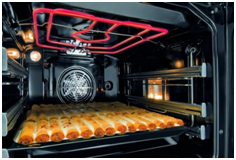
Grill Principles
All electric stoves that meet modern requirements are equipped with a grill. This option is implemented thanks to several heating elements. They direct their energy to baked goods. And this process in different modes is uniform. You can adjust it with the regulators that are located on the control panel. They are combined, mechanical.
Summary
Today, electric stoves are not only original ways for convenient and high-quality cooking. They still contribute to your kitchen interior. And each buyer has the opportunity to purchase a modification that has a classic or modern style. The assortment includes devices of different parameters, color versions. They have a wide range of functions. All this allows you to find a model for personal priorities.
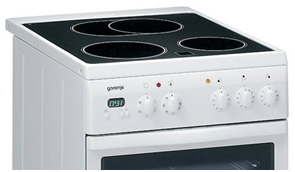

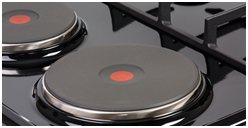
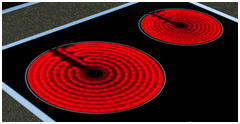
in the hostel I’m used to the electric stove and that’s all for life =))) therefore I also took an electric indesit to my apartment. convenient, simple, works perfectly.
I picked up a hotpoint for a retro style, so it didn’t matter, gas or electric. took the electric train. at first it’s a little unusual, but now I just can’t part with it